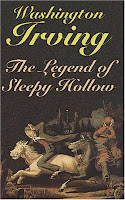 Dracula - Published in 1897, Dracula has become the classic story of a vampire. This story, by Bram Stoker, was inspired by Stoker's years of research on vampires and European folklore. Written as a series of letters, diary entries, and newspaper clippings, Stoker presented the story as if it was had really happened. Stoker was interested in tales of Vlad the Impaler and included him in his story of a vampire who was creepy and classy by turns.
Dracula - Published in 1897, Dracula has become the classic story of a vampire. This story, by Bram Stoker, was inspired by Stoker's years of research on vampires and European folklore. Written as a series of letters, diary entries, and newspaper clippings, Stoker presented the story as if it was had really happened. Stoker was interested in tales of Vlad the Impaler and included him in his story of a vampire who was creepy and classy by turns.Frankenstein: or the Modern Prometheus - In 1816, Mary Shelley created this tale of terror during a night of drunken debauchery with her husband, Percy Bysshe Shelley, her stepsister Claire Clairmont, Lord Byron and his doctor, Dr. John Polidori. While Mary initially considered this to be a good start to a short story, eventually it became the novel Frankenstein. Mary may have been inspired by tales of Johann Conrad Dippel, who conducted experiments in reanimation at Castle Frankenstein, near Geneva. While Dippel's experiments likely involved animals, rumors persisted that he had in fact raided graveyards for human corpses. In the end, Dippel's only discovery was the dye, Prussian Blue, which may have been the cause of his death.
The Strange Case of Dr. Jekyll and Mr. Hyde - Written in 1885 by Robert Louis Stevenson, this story was nearly discarded by the author before it was published. Stevenson was ill at the time and was confined to bed. His wife heard him cry out and went to wake him, at which point, he said, "Why did you wake me? I was dreaming a fine bogey tale." Inspired by the dream, Stevenson completed the first draft of the story in less than three days. His wife read the story and offered her comments that it should be an allegory and was a truly frightening start. Stevenson burned the first manuscript, either because it scared his wife, or because he wanted to change it to an allegorical tale. He then spent the next six days rewriting the manuscript that became Dr. Jekyll and Mr. Hyde.
The Collected Tales of Edgar Allen Poe - Between 1826 & 1848, Poe wrote many horrifying tales of terror. Among them are The Raven, in which a bird torments a man by it's mere presence, The Tell-Tale Heart, in which a man has committed murder and is tormented by the ghostly beating of the dead man's heart, and The Murders in the Rue Morgue, in which a mysterious figure has killed a family in an impossible manner. Other tales, several of which have been made into movies starring Vincent Price, include: The Masque of the Red Death, A Cask of Amontillado, The Fall of the House of Usher, and The Pit and the Pendulum.
The Legend of Sleepy Hollow - Written by Washington Irving in 1820, the story was based on an old German folktale set in Sleepy Hollow, New York. The Dutch settlers told tales of a spectral horseman that rode through the Hollow, frightening the locals. Irving may have based some of the characters, such as Katrina Van Tassel and Ichabod Crane, on local residents that he knew. Even the names are variations of locals that Irving spent time with.
The Monkey's Paw - Written in 1902, this short story by W. W. Jacobs, reminds us to be careful what you wish for. The plot revolves around a monkey's paw, blessed by a fakir in India, that will grant three wishes each to three different men. Sergeant-Major Morris, who possesses the paw, tells a old friend of the paw, but warns him and his family of the sorrow it brings, saying, "It had a spell put on it by an old fakir, a very holy man. He wanted to show that fate ruled people's lives, and that those who interfered with it did so to their sorrow."
The Picture of Dorian Gray - Published in 1890, this terrifying tale by Oscar Wilde tells the story of young Dorian Gray, a man of astonishing physical beauty. After having his portrait painted, young Gray meets a man who convinces him that the only things worth pursuing are beauty and pleasure. Gray agrees, but wishes that he could sell his soul so that his portrait could age instead of him. His wish is granted, with each horrific act of debauchery appearing as disfigurement of the portrait as a reflection of the damage to his soul.
For a good scare, a small thrill of terror, a story that will make you jump at the smallest sound, try one of these classics. They're creepy good fun!







No comments:
Post a Comment